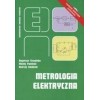- Out-of-Stock



Chwaleba A., Poniński M., Siedlecki A.
The manual discusses the basics of electrical metrology, as well as the classification, principles of operation and metrological properties of measurement tools. The description of traditional structural solutions of devices, transducers and measurement systems has been limited. Much more attention has been paid to modern analog, analog-to-digital and digital-to-analog converters, multifunctional digital multimeters as well as structures and organization of measurement systems.
The ninth edition updates Chapter 2 on the calculation of errors and Chapter 17 on the estimation of the measurement result taking into account its uncertainty.
The manual is intended for students of electrical faculties of technical colleges. It can also be useful for electrical and electrical engineers and technicians.
Table of Contents
List of important markings
1. Basic concepts
1.1 Physical object, physical quantity (measurable)
1.2. Measurement process
1.3. Unit of measure, size systems and units of measurement
1.4. Measuring tools
1.5. Measurement methods
1.6. Processing methods
2. Basics of error calculation
2.1. Classification of measurement errors
2.2. Systematic errors
2.3. Random errors
2.4. Calculation of boundary errors during direct measurements
2.5. Error calculation for indirect measurements
2.6. Development of measurement results
2.7. Determination of processing characteristics based on measurement results
3. General information about measuring tools
3.1. The principles of division, functional and structural diagrams of measurement tools
3.2. Divisions of measuring instruments and transducers according to fulfilled functions
3.3. Division of instruments and measuring transducers due to the initial character
measurement information
3.4. Structure of measuring instruments and transducers
3.5. Static properties of measuring instruments and transducers
3.6. Dynamic properties of measuring instruments and transducers
3.7. The rules for the selection of measuring tools in the measurement process
4. Standards of electrical units and sources of reference signals
4.1. Pattern hierarchy
4.2. Standard DC power sources
4.3. Sources of reference constant voltages
4.4. Resistance patterns
4.5. Capacity patterns
4.6. Inductance standards
4.7. Sources of reference frequencies
5. Measuring transducers of electrical quantities
5.1. Introduction
5.2. Bypasses
5.3. Additional resistors (posts)
5.4. Voltage dividers
5.5. Gates
5.6. Alternating current transformers
5.7. DC transformers
5.8. Measuring amplifiers
5.9. Rectifier transducers
5.10. Sampling transducers
5.11. Thermoelectric converters of effective value
5.12. Multiplicating transducers
5.13. AC power converters
5.14. Digital-to-digital converters (C / C)
5.15. Digital-to-analogue converters (C / A)
5.16. Analog-to-digital converters (A / C)
6. Analog meters
6.1. Introduction
6.2. Magnetoelectric meters
6.3. Magnetoelectric meters with transducers
6.4. Galvanometers
6.5. Electromagnetic meters
6.6. Electrodynamic and ferrodynamic meters
6.7. Electrostatic meters
7. Digital meters
7.1. Introduction
7.2. Frequency meters and digital timers
7.3. Digital phasometers
7.5. Digital resistance, capacitance and inductance meters
7.6. Digital multimeters
8. Electricity meters
8.1. Introduction
8.2. Electromechanical electricity meters for alternating current
8.3. Electronic AC energy meters
8.4. DC meters
9. Recording devices
9.1.Wprowadzenie
9.2. Direct processing recorders
9.3. Intermediate recorders
9.4. XY recorders
9.5. Recorders with magnetic tape
9.6. Analog oscilloscopes
9.7. Analog sample oscilloscopes
9.8. Digital oscilloscopes
10. Measuring bridges
10.1. DC bridges
10.2. Alternating current bridges
11. Compensators
11.1. DC voltage compensators
11.2. DC compensators
11.3. Automatic permanent voltage compensators
11.4. AC voltage compensators
12. Measuring systems
12.1. Introduction
12.2. Contemporary measuring systems
12.3. Measurement systems software
12.4. The rules for completing the measurement system
13. Measurements of electric quantities
13.1. Models of studied objects
13.2. Resistance measurements
13.3. Measurements of inductance, capacity and loss resistance
13.4. Frequency measurements
13.5. Measurements of active power
13.6. Reactive power measurements
13.7. Phase shift measurements 13.8. Measurements of nonlinear distortions and spectral analysis
13.9. Measurements of non-sinusoidal currents and alternating voltages
14. Measurements of magnetic quantities
14.1. Measurements of the magnetic field
14.2. Measurements of the properties of magnetic materials
15. Measurements of non-electrical quantities
15.1. Introductory information
15.2. Measurements of geometric dimensions
15.3. Measurements of forces and moments
15.4. Pressure measurements
15.5. Measurements of traffic parameters
15.6. Temperature measurements
16. National service of measures
16.1. Basic tasks
16.2. Organization
16.3. norms
17. Estimation of the measurement result including its uncertainty
Literature
Index
No product available!
Crimping tool HT106L by Prosonic, supports connectors: F59, F11, F6, UHF58, HF8
No product available!
Stylish spacecraft-shaped case for Raspberry Pi 4 model B minicomputers. Made of durable ABS plastic and has a built-in cooling fan. Waveshare PI4-CASE-F
No product available!
No product available!
No product available!
No product available!
LCD TFT 3.50 ", 320x240, SSD1963 controller, resistive touch panel, Winstar, RoHS
No product available!
No product available!
DS100B - converter module RS232 / 422/485 Ethernet 10BaseT
No product available!
The housing for Orange Pi Plus is transparent, with snaps. The installation does not require the use of glue. The housing is made of high quality plastic. All openings made in the housing allow easy access to every socket built in Orange Pi Plus
No product available!
No product available!
ROSA3D filament made of high-quality PLA-Silk granules characterized by intense color and exceptional gloss. 0.8 kg of filament with a diameter of 1.75 mm is wound on the spool. Filament ROSA3D PLA-Silk Bronze
No product available!
The Raspberry Pi GPIO Triple Expansion Board converts the single GPIO headers on your Raspberry Pi into three parts. DFR0385
No product available!
Turnigy Multistar 20 A - Brushless motor controller for 2-4S multirotors (OPTO) (HK27775)
No product available!
No product available!
TEST PLATE FOR BASCOM AVR COURSE MICROPROCESSOR COIL JOINT - A KIT FOR INDEPENDENT INSTALLATION
No product available!

Chwaleba A., Poniński M., Siedlecki A.
